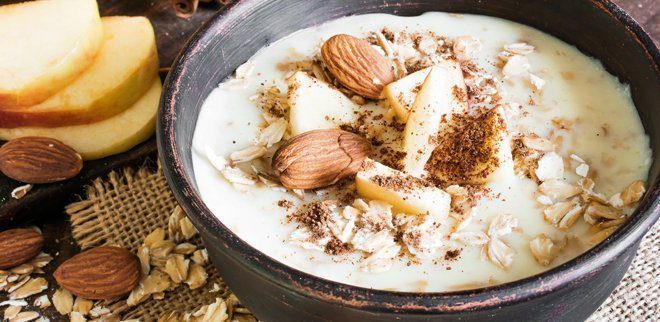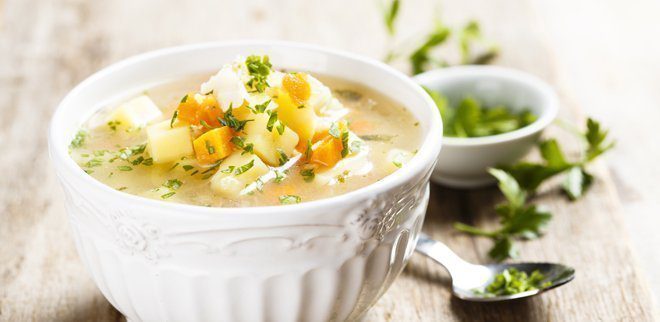The lesson of long life begins in the kitchen. If you want to cook Ayurvedic, you need this know-how about Ayurvedic nutrition at the stove.
ÜTranslated, Ayurveda means “the teaching of a long life”. It is only logical that nutrition plays an important role in this. The goal of Ayurvedic nutrition is that all bodily functions are brought into balance through food in such a way that the organism can function as well as possible and diseases do not develop in the first place.
Here you go directly to the Ayurveda recipes.
Ayurvedic Diet: Vata, Pitta, Kapha
According to Ayurvedic teaching, there are three so-called doshas, i.e. biological energies, which flow through the human organism in different forms. These doshas are called Vata, Pitta and Kapha and should be able to be perfectly balanced with a targeted Ayurvedic diet .
- Vata stands for the elements air and space and thus for properties such as alertness, clarity and dynamism. If there is an imbalance in Vata, this leads to nervousness, sleep disorders and loss of appetite.
- Pitta , on the other hand, stands for fire and at the same time for the activity of the digestive system and metabolism . With an unbalanced Pitta, those affected often suffer from digestive disorders or excessive irritability.
- Kapha , on the other hand, describes the stabilizing earth element that conveys calm and strength. An imbalance in this leads to sluggishness and obesity .
The six Ayurveda flavors
The Ayurvedic diet tries to balance the doshas with every meal. Among other things, because it combines the six flavors of Ayurveda in every meal: sweet , sour, salty, bitter, tart and hot.
According to Ayurvedic nutrition, foods such as cereals , sweet vegetables , fruit , but also milk and meat are considered sweet. Vinegar, lemon, sour fruits, yoghurt or tomatoes are sour . Salt and soy sauce fall under the salty category, while chili , ginger , pepper, horseradish, and mustard fall under the hot category. Foods such as leafy vegetables, lettuce, garden herbs and coffee are bitter in the sense of Ayurvedic cuisine . And tart ingredients are legumes, cabbage , sage or rocket.
Ayurvedic diet: additional rules
- Between the three main meals, no snacks should be eaten for at least three hours. The reason is the activity of the digestive tract, which should be completed before new food is added.
- Ideally, food is always heated and drinks are taken at least at room temperature.
- Not much is thought of raw food not only because it is too cold, but also because it is difficult to digest.
- A special ritual of Ayurvedic nutrition is the obligatory glass of water after waking up. Ideally, the water should be non-carbonated, lukewarm and peppered with a slice of ginger . Anyone who treats themselves to this health drink immediately after waking up activates intestinal activity and thus their spirits.
Tasting: Ayurvedic recipes
If you want to eat Ayurvedic, these recipes accompany you perfectly through the day:
Ayurvedic breakfast: Warm cereal porridge

ingredients
- 100 grams of grain flakes of your choice (e.g. oat flakes)
- 30 grams of nuts of your choice (e.g. almonds or hazelnuts)
- 30 grams of raisins
- fresh grated ginger
- 1 tablespoon clarified butter (ghee)
- 1 apple
- a pinch of cinnamon
- agave syrup
preparation
The clarified butter is heated in a saucepan and the ginger, nuts and raisins are briefly roasted in it. Now the cereal flakes are added and briefly mixed with the rest before adding enough water until the whole thing reaches the desired consistency. In another pot, sauté the finely chopped apple with a little cinnamon until soft. Now all the ingredients have to be mixed together and sweetened to taste with agave syrup.
Ayurvedic lunch: Lukewarm bean salad

ingredients
- 1 cup of rice
- 1 small can of kidney beans
- 200 grams of green beans
- 1 bunch of parsley
- 1 mango
- 2 tbsp olive oil
- 1 onion
- 1 lemon
- 150 grams of feta
- a bit of salt
- 1 tablespoon of sugar
- 2 cardamom pods
preparation
The beans are cut into bite-sized pieces and cooked al dente. The rice is also cooked and briefly cooled. Meanwhile, the mango needs to be peeled and cut into small pieces. Now finely chop the parsley and finely grind the cardamom pods with a mortar and pestle. These ingredients are now mixed together. Then the onions are chopped and sautéed in a little olive oil until translucent. Remove the onions from the heat and puree with the lemon juice, sugar and the remaining olive oil. The puree is now poured over the bean salad and everything is mixed well.
Ayurvedic dinner: light root cream soup
 ingredients
ingredients
- 1 large bulb of fennel
- 1 leek
- 2 potatoes
- ¼ celeriac
- ½ tsp cumin seeds
- ½ tsp mustard seeds
- ½ tsp paprika powder
- 1 dash of apple cider vinegar
- ½ liter vegetable broth
- 1 tsp garam masala
- 1 tsp clarified butter
- a bit of salt
- some fresh grated ginger
- Parsley or coriander to taste
preparation
First, the butter is heated in a large pot and the mustard and cumin seeds are lightly roasted in it. Now add the finely chopped leek and also sauté lightly. The broth is then poured into the pot and the vegetables are cooked in it. Then take the soft vegetables out of the pot, puree them finely and then add them back to the broth. Now the whole thing is seasoned with garam masala, apple cider vinegar, paprika powder and a little salt. When serving, the chopped parsley and ginger can then be added to the soup.



 ingredients
ingredients




